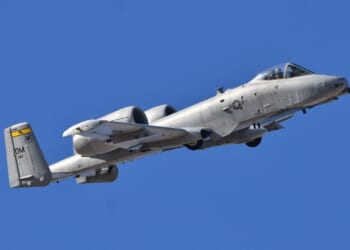Thus far, the F-14 Tomcat’s primary role—fleet air defense—has yet to be fully replicated by any of its successors.
In September 2006, the United States lost its need for speed. That was the year that the final F-14 Tomcat flight took place. Having first been introduced in the 1970s, this iconic warplane said goodbye to fans around the world on September 22, 2006, after more than 30 years in service. The Boeing F/A-18E/F Super Hornet replaced the Tomcat from that point onward, proving itself to be a capable successor—in the midst of America’s wars in Afghanistan and Iraq—but nowhere near as legendary as the F-14 Tomcat had proven itself to be.
Interestingly, the US Navy’s retirement of the F-14 left only one nation in the world continuing to operate the aircraft: the Islamic Republic of Iran, which has continued to maintain a small fleet of the aircraft inherited from the Shah in 1979. As the Tomcat has grown more obsolete, and spare parts more sparse, the Iranian F-14 fleet has dwindled. Some reports indicate that it may have been destroyed entirely during the recent “Operation Rising Lion” Israeli strikes on Iran—which, if true, would mean that the F-14 has finally been retired for good.
The F-14 Tomcat’s Specifications
- Year Introduced: 1974
- Number Built: 712
- Length: 62 ft 9 in (19.13 m)
- Height: 16 ft (4.9 m)
- Wingspan: 64 ft 1.5 in (19.55 m) normal; 38 ft 2.5 in (11.65 m) swept
- Weight: 61,000 lb (27,669 kg) MTOW
- Engines: Two General Electric F110-GE-400 afterburning turbofans, 16,333 lbf (72.65 kN) thrust each dry
- Top Speed: Mach 2.34 (1,544 mph, 2,485 km/h)
- Range: 503 nmi (579 mi, 932 km) combat range
- Service Ceiling: 53,000 ft (16,000 m)
- Loadout: One 20mm M61A1 Vulcan rotary cannon; 10 hardpoints; 14,500 lb (6,600 kg) total payload capacity
- Aircrew: 2
The Final Countdown to the Big Goodbye
On February 8, 2006, the F-14’s final combat mission for the United States Navy occurred during Operation Iraqi Freedom (OIF). A pair of Tomcats from Fighter Squadron 31 (VF-31), also known as the “Tomcatters” and the VF-213 “Black Lions,” dropped a single 500-pound GBU-38 Joint Direct Attack Munition (JDAM) bomb over Iraq before trapping aboard the USS Theodore Roosevelt (CVN-71). This marked the final mission of the Tomcat’s combat era, with VF-31 and VF-213 logging over 1,163 sorties and 6,678 flight hours on their last deployment—dropping about 9,500 pounds of ordnance in total.
In terms of the Tomcat’s final “cat-shot,” or catapult launch” from an aircraft carrier, that occurred on July 28, 2006, from the USS Theodore Roosevelt. This involved an F-14D Tomcat nicknamed “Felix One,” from VF-31. That final cat-shot flight was piloted by US Navy Commander Jim “Puck” Howe with Lieutenant Mike “Mooch” Petronis as the plane’s Radar Intercept Officer (RIO).
“Felix One” was a particularly storied airframe of the F-14 family. It famously strafed Taliban forces with its mighty M61 Vulcan cannon during Operation Enduring Freedom (OEF) in Afghanistan in 2001. This specific bird flew 175 combat sorties in its final deployment. It was fitting that the final cat-shot launch would have been done with Felix One.
The Final Flight of America’s F-14 Tomcat
September 22, 2006, was the date of the official final flight from Naval Air Station (NAS) Oceana in Virginia Beach, Virginia. That event was dubbed the “Tomcat Sunset” and drew a huge crowd of onlookers—demonstrating how popular this plane was, not only in military aviation circles but among the public—and included powerful send-off speeches from high-ranking military officials, such as Admiral John Nathman, Captain John McCandlish, and representatives from Northrop Grumman, the defense firm that produced the F-14 Tomcat.
That final flight was conducted by Lieutenant Commander Chris Richard, with Lieutenant Petronis as RIO—having previously been the RIO on the final cat-shot launch from the USS Theodore Roosevelt two months earlier. The bird they used for that final flight was not the originally planned plane, due to that plane’s mechanical failures before the flight was scheduled. Instead, the two Navy pilots took the backup plane. Once launched from NAS Oceana, the F-14D performed what is known as a “flypast” over the crowd before heading into the horizon (hence why the event was dubbed “Tomcat Sunset”).
The day before the final flyby of the F-14D Tomcat, as part of the retirement ceremony, the Navy unveiled a Tomcat monument dedication. The day after the flyby, the Navy held a symposium discussing the F-14’s tremendous impact on US Naval lore and naval aviation development.
The aircraft was officially stricken from Navy records on September 28, 2006, just a few days after its retirement ceremony at NAS Oceana.
The Tomcat’s Final, Final Flight Was Actually Two Weeks Later
But that September 21-23, 2006, event was not the final goodbye. That event was merely the public retirement ceremony. The very last flight of the US Navy’s F-14 occurred on October 4, 2006, when “Felix One,” the plane that conducted the last cat-shot in July 2006 from the Theodore Roosevelt, was ferried from NAS Oceana to Republic Airport in Farmingdale, New York, for historical preservation. US Navy pilots Commander Chris “Limp” Richard piloted, while Lieutenant Commander Fitz Gentry served as that final flight’s RIO.
At Farmington, NY, Felix One was ultimately restored. Since September 14, 2023, that plane has been placed on permanent display at the Cradle of Aviation Museum in Garden City, New York, sponsored by Northrop Grumman.
As if saying goodbye wasn’t enough, to show how done with the F-14 they were, the Pentagon ordered the remaining F-14 airframes held at the “boneyard” at Davis-Monthan Air Base in Arizona shredded between 2007-09. This was not done out of sentiment, but rather to prevent any of those aircraft’s spare parts from reaching Iran, at that point the world’s final Tomcat operator.
Was the F-14 Tomcat Put Down Too Soon?
Yet, there remains much debate as to whether the Navy made the right call in retiring the F-14 Tomcat in 2006. Many “Tomcatters” wanted to see the life cycle of these iconic birds extended; while the F/A-18 Super Hornet was an able plane, it did not possess some of the fleet defense capabilities that the F-14s had. Others wanted Northrop Grumman to move forward with plans for the now-cancelled F-21 Super Tomcat.
Today, even the F/A-18E/F Super Hornet is on the chopping block, as the Navy pleads with skeptical lawmakers to fork over even more money to the maritime branch to replace the Super Hornet with the proposed F/A-XX sixth-generation warplane. Thus far, however, the Tomcat’s primary role—fleet air defense—has yet to be fully replicated by any of its successors. In the age of renewed great power competition and conflict, that is a major problem that the Navy has yet to fully address.
About the Author: Brandon J. Weichert
Brandon J. Weichert is a senior national security editor at The National Interest. Recently, Weichert became the host of The National Security Hour on America Outloud News and iHeartRadio, where he discusses national security policy every Wednesday at 8pm Eastern. He is also a contributor at Popular Mechanics and has consulted regularly with various government institutions and private organizations on geopolitical issues. Weichert’s writings have appeared in multiple publications, including The Washington Times, National Review, The American Spectator, MSN, The Asia Times, and others. His books include Winning Space: How America Remains a Superpower, Biohacked: China’s Race to Control Life, and The Shadow War: Iran’s Quest for Supremacy. His newest book, A Disaster of Our Own Making: How the West Lost Ukraine is available for purchase wherever books are sold. He can be followed via Twitter @WeTheBrandon.
Image: Shutterstock / Miguel Lagoa.


















